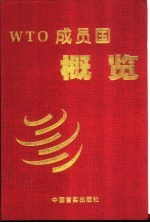图书介绍
WTO成员国概览 第6卷PDF|Epub|txt|kindle电子书版本网盘下载

- 本书编委会编 著
- 出版社: 北京:中国言实出版社
- ISBN:7801283546
- 出版时间:2002
- 标注页数:694页
- 文件大小:45MB
- 文件页数:709页
- 主题词:
PDF下载
下载说明
WTO成员国概览 第6卷PDF格式电子书版下载
下载的文件为RAR压缩包。需要使用解压软件进行解压得到PDF格式图书。建议使用BT下载工具Free Download Manager进行下载,简称FDM(免费,没有广告,支持多平台)。本站资源全部打包为BT种子。所以需要使用专业的BT下载软件进行下载。如BitComet qBittorrent uTorrent等BT下载工具。迅雷目前由于本站不是热门资源。不推荐使用!后期资源热门了。安装了迅雷也可以迅雷进行下载!
(文件页数 要大于 标注页数,上中下等多册电子书除外)
注意:本站所有压缩包均有解压码: 点击下载压缩包解压工具
图书目录
上篇 拉丁美洲 WTO 成员国5
第一章 阿根廷5
一、自然概况5
(一)地理5
(二)地形地貌5
(三)气候5
(四)资源5
(一)国家发展简史6
二、社会概况6
(二)政治7
(三)人口7
(四)文化8
(五)主要城市8
三、经济概况10
(一)经济发展简史10
(二)国内经济12
(三)对外经济20
(四)资源29
(三)气候29
(一)国家发展简史29
(二)人口和文化29
二、社会概况29
(二)地形地貌29
(一)地理29
一、自然概况29
第二章 巴拉圭29
三、经济概况30
(一)经济发展简史30
(二)国内经济30
(三)对外经济31
(一)国家发展简史35
二、社会概况35
(四)资源35
(三)气候35
(二)地形地貌35
(一)地理35
一、自然概况35
第三章 巴拿马35
(二)政治36
(三)人口37
(四)文化37
(五)主要城市38
三、经济概况39
(一)经济发展简史39
(二)国内经济41
(三)对外经济43
(三)气候49
(二)地形地貌49
(四)资源49
一、自然概况49
(一)地理49
第四章 巴西49
二、社会概况50
(一)国家发展简史50
(二)政治51
(三)人口52
(四)文化52
(五)主要城市53
三、经济概况54
(一)经济发展简史54
(二)国内经济55
(三)对外经济62
第五章 秘鲁73
一、自然概况73
(一)地理73
(二)地形地貌73
(三)气候73
(四)资源73
二、社会概况74
(一)国家发展简史74
(三)人口75
(四)文化75
(二)政治75
(五)主要城市76
三、经济概况79
(一)经济发展简史79
(二)国内经济84
(三)对外经济87
(三)气候95
(一)国家发展简史95
二、社会概况95
(四)资源95
(二)地形地貌95
(一)地理95
一、自然概况95
第六章 玻利维亚95
(二)人口96
(三)文化96
三、经济概况96
(一)经济发展简史96
(二)国内经济96
(三)对外经济99
(二)人口103
(一)国家发展简史103
二、社会概况103
(三)气候103
(四)资源103
(一)地理103
一、自然概况103
第七章 厄瓜多尔103
(二)地形地貌103
(三)文化104
三、经济概况104
(一)经济发展简史104
(二)国内经济104
(三)对外经济106
(一)地理109
(二)地形地貌109
第八章 哥伦比亚109
一、自然概况109
(三)气候110
(四)资源111
二、社会概况113
(一)国家发展简史113
(二)政治114
(三)人口122
(四)文化124
(五)主要城市129
(一)经济发展简史132
三、经济概况132
(二)国内经济134
(三)对外经济141
第九章 古巴157
一、自然概况157
(一)地理157
(二)地形地貌157
(三)气候158
(四)资源158
(一)国家发展简史159
二、社会概况159
(二)政治160
(三)人口161
(四)文化161
(五)主要城市164
三、经济概况166
(一)经济发展简史166
(二)国内经济166
(三)对外经济173
(四)资源183
(三)气候183
二、社会概况183
(一)国家发展简史183
(一)地理183
一、自然概况183
第十章 圭亚那183
(二)地形地貌183
(二)人口184
(三)文化184
(四)行政区划和主要城市184
三、经济概况184
(一)经济发展简史184
(二)国内经济185
(三)对外经济187
(一)地理191
(二)地形地貌191
一、自然概况191
第十一章 墨西哥191
(三)气候192
(四)资源192
二、社会概况194
(一)国家发展简史194
(二)政治195
(三)人口204
(四)文化204
(五)主要城市209
三、经济概况215
(一)经济发展简史215
(二)国内经济217
(三)对外经济233
一、自然概况261
(一)地理261
(二)地形地貌261
(三)气候与资源261
二、社会概况261
三、经济概况261
(一)国内经济261
第十二章 苏里南261
(二)对外经济262
(一)地理265
(二)地形地貌265
一、自然概况265
第十三章 委内瑞拉265
(三)气候266
(四)资源266
二、社会概况267
(一)国家发展简史267
(二)政治267
(三)人口268
(四)文化269
(五)行政区划与主要城市270
三、经济概况272
(一)经济发展简史272
(二)国内经济273
(三)对外经济283
(四)资源291
二、社会概况291
(三)气候291
(一)国家发展简史291
(二)人口291
(一)地理291
一、自然概况291
第十四章 乌拉圭291
(二)地形地貌291
(三)文化292
(四)主要城市292
三、经济概况292
(一)经济发展简史292
(二)国内经济292
(三)对外经济293
一、自然概况297
(一)地理297
第十五章 智利297
(二)地形地貌300
(三)气候301
(四)资源303
二、社会概况303
(一)国家发展简史303
(二)政治304
(三)人口306
(四)文化306
三、经济概况306
(一)经济发展简史306
(二)国内经济309
(三)对外经济315
(二)地形地貌323
(一)地理323
(三)气候323
下篇 大洋洲 WTO 成员国323
一、自然概况323
第一章 澳大利亚323
(四)资源324
二、社会概况325
(一)国家发展简史325
(二)政治325
(三)人口327
(四)文化328
(五)主要城市332
(一)经济发展简史334
三、经济概况334
(二)国内经济336
(三)对外经济345
第二章 巴布亚新几内亚361
一、自然概况361
(一)地理361
(二)地形地貌361
(三)气候361
(四)资源361
二、社会概况361
(一)国家发展简史361
(一)经济发展简史362
三、经济概况362
(二)国内经济362
(二)政治362
(四)文化362
(三)人口362
(五)主要城市362
(三)对外经济363
(三)气候367
二、社会概况367
(四)资源367
(一)国家发展简史367
(二)地形地貌367
(一)地理367
一、自然概况367
第三章 斐济367
(二)政治368
(三)人口368
(四)文化368
(五)主要城市368
三、经济概况368
(一)经济发展简史368
(二)国内经济369
(三)对外经济371
(二)人口与文化375
(一)国家发展简史375
二、社会概况375
(四)资源375
(二)地形地貌375
(一)地理375
一、自然概况375
第四章 所罗门群岛375
(三)气候375
三、经济概况376
第五章 新西兰379
一、自然概况379
(一)地理379
(二)地形地貌379
(三)气候379
(一)国家发展简史380
(四)资源380
二、社会概况380
(二)政治381
(三)人口382
(四)文化383
(五)主要城市387
三、经济概况389
(一)经济发展简史389
(二)国内经济392
(三)对外经济398
Ⅰ.Basics417
1.What is the World Trade Organization?417
PART Ⅰ THE WTO417
附录 WTO 简介(英文版)417
2.Principles of the Trading System418
3.The Case for Open Trade421
4.Roots:from Havana to Marrakesh423
5.The Uruguay Round424
6.The WTO and GATT——are They the Same?426
Ⅱ.The Agreements428
1.Overview:a Navigational Guide430
2.Tariffs:More Bindings and Closer to Zero432
3.Agriculture:Fairer Markets for Farmers433
4.Textiles:Back in the Mainstream438
5.Intellectual Property:Protection and Enforcement440
6.Anti-Dumping,Subsidies,Safeguards:Contingencies,etc443
7.Non-Tariff Barriers:Technicalities,Red Tape,etc448
8.Plurilaterals:of Minority Interest452
9.Trade Policy Reviews:Ensuring Transparency453
Ⅲ.Settling disputes455
1.The WTO’s“Most Individual Contribution”455
2.Case Study:the Timetable in Practice459
Ⅳ.Beyond the agreements461
1.Overview461
2.Already Committed:the“Built-in Agenda”461
3.Regionalism——Friends or Rivals?463
4.The Environment——a New High Profile465
5.Investment,Competition,Procurement,Simpler Procedures468
6.The Tuna-Dolphin Dispute470
7.Labour Standards:Not on the Agenda472
V.Developing Coruntries473
1.Overview473
2.Committees476
3.WTO Technical Cooperation478
4.Issues478
5.Q A(1):Some Common Themes480
6.Q A(2):a Declaration of Independence481
7.Q A(3):WTO Membership and the Need to be Heard483
Ⅵ.The Organization484
1.Whose WTO Is It Anyway?485
2.Membership,Alliances and Bureaucracy487
3.The Secretariat490
4.Special Policies491
Ⅶ.The WTO in Brief493
1.The Multilateral Trading System——Past,Present and Future493
2.The WTO Agreements494
3.Developing Countries495
Ⅷ.10 Benefits of the WTO Trading System496
1.The System Helps to Keep the Peace497
2.The System Allows Disputes to be Handled Constructively498
3.A System Based on Rules Rather than Power Makes Life Easier for All499
4.Freer Trade Cuts the Cost of Living499
5.It Gives Consumers More Choice,and a Broader Range of Qualities to Choose From501
7.Trade Stimulates Economic Growth,and That Can be Good News for Employment502
6.Trade Raises Incomes502
8.The Basic Principles Make the System Economically More Efficient,and They Cut Costs503
9.The System Shields Governments from Narrow Interests504
10.The System Encourages Good Government505
Ⅸ.Common Misunderstandings About the WTO506
1.The WTO Dictates Governments’ Policies506
2.The WTO is Blindly for Free Trade at any Cost507
3.The WTO is Only Concerned About Commercial Interests.This Takes Priority Over Development.508
4.In the WTO,Commercial Interests Take Priority Over Environmental Protection508
5.The WTO Dictates to Governments on Issues Such as Food Safety,and Human Health and Safety.Again Commercial Interests Override508
6.The WTO Destroys Jobs,Widens the Gap Between Rich and Poor509
7.Small Countries are Powerless in the WTO510
9.Weaker Countries Have no Choice,They are Forced to Join the WTO511
8.The WTO is the Tool of Powerful Lobbies511
10.The WTO is Undemocratic512
PART Ⅱ TRADE TOPICS515
Ⅰ.Overview of Trade Facilitation Work in the WTO515
Ⅱ.Anti-Dumping521
1.Agreement on Implementation of Article VI of the General Agreement on Tariffs and Trade 1994521
2.Notifications Under the Agreement on Implementation of Article VI of GATT 1994527
Ⅲ.The WTO Agreements529
1.Introduction529
2.Agreement Establishing the World Trade Organization530
3.General Agreement on Tariffs and Trade 1994530
4.Uruguay Round Protocol GATT 1994531
5.Agreement on Agriculture532
8.Agreement on Textiles and Clothing535
6.Agreement on Sanitary and Phytosanitary Measures535
7.Decision on Measures Concerning the Possible Negative Effects of the Reform Programme on Least-Developed and Net Food-Importing Developing Countries535
9.Agreement on Technical Barriers to Trade537
10.Agreement on Trade Related Aspects of Investment Measures538
11.Agreement on Implementation of Article Ⅵ(Anti-Dumping)538
12.Agreement on Implementation of Article Ⅶ(Customs Valuation)540
13.Agreement on Preshipment Inspection540
14.Agreement on Rules of Origin540
15.Agreement on Import Licensing Procedures541
16.Agreement on Subsidies and Countervailing Measures542
17.Agreement on Safeguards544
18.General Agreement on Trade in Services545
19.Agreement on Trade Related Aspects of Intellectual Property Rights,Including Trade in Counterfeit Goods549
20.Settlement of Disputes552
21.Trade Policy Review Mechanism554
PART Ⅲ THE AGREEMENTS557
Ⅰ.The WTO557
1.WTO VS GATT557
2.The Uruguay Round586
3.Module 1:FAQs600
Ⅱ.Market Access606
1.GATT 1994607
2.Agricuture620
3.Textiles and Clothing640
4.Tariffs QRs and Co661
5.Module 2:FAQS681